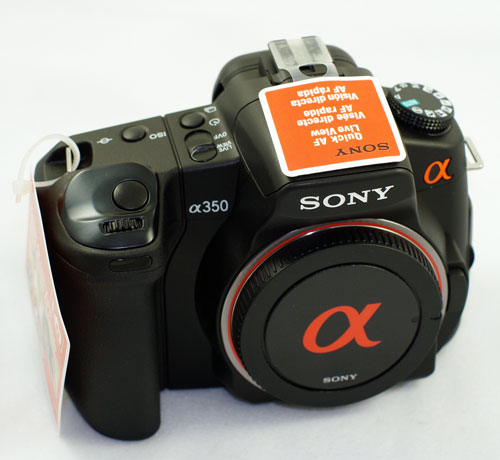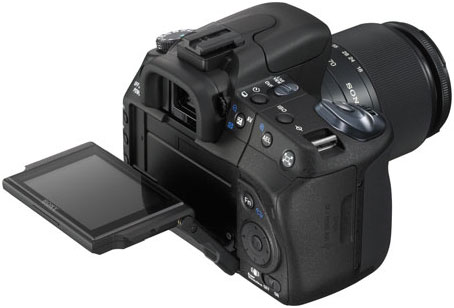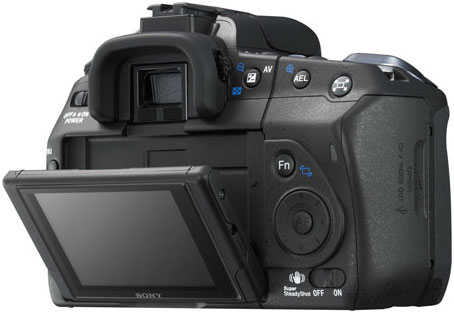Sony A350: Full-Time Live View at 14.2MP
by Wesley Fink on April 3, 2008 3:00 AM EST- Posted in
- Digital Camera
Features and Handling
Sony is used to playing in the large volume retail space where every trick used to gain visibility can result in higher sales.

This is very clear in the packaging theme for Sony DSLR cameras and accessories. No one will miss the bright orange and white (or bright orange and silver) that makes the Sony packages stand out.

The A350 body is on the small side, like the other Sony entry DSLR models, without the extreme smallness that seems to some a problem with the Canon XTi or Nikon D60/D40x. The new Canon XSi is a bit larger than the previous model to address size complaints and accommodate a 3.0" LCD. The Sony A350 is both a little wider (5.25" vs. 5.1") and taller (4.0" vs. 3.8") than the upsized XSi. Minolta pioneered body-integral image stabilization, and the evolved Sony Super Steady Shot is a feature on every Sony DSLR, along with auto sensor cleaning.
The top deck contains a single dial to adjust mode (full-auto, program, shutter-priority, and aperture-priority) and a wide selection of special scene programs such as portrait, sports, night, etc. On the opposite side of the viewfinder hump you will find a mechanical (no power required) Live View/OVF (Optical Viewfinder) switch, timer/drive mode button, and ISO button. The shutter release and shift/adjust dial are on top of the comfortable handgrip.

9-point auto-focus is featured on the A350. The layout and pattern is the same as the A200, A300, and earlier A100 suggesting it is the same AF module. The burst AF speeds on all models also support the conclusion that this is likely the same venerable AF module used in previous Minolta and Sony digital SLRs. Sony claims faster AF in the newest models, and that is likely the result of faster data processing in the supporting data processing modules in the DSLR. The prosumer A700 uses an updated and faster 11-point AF system. The A350 AF system is very competitive in its class and a big step up from the Olympus 510/410/420 and Nikon D60/D40x 3-point AF modules.


While the A350 is a bit larger than the Canon XSi, the LCD is 2.7" instead of the 3.0" LCD featured on the XSi. However, it is the only LCD in its class that is articulated, allowing an upward tilt as far as perpendicular for low-level shots and a down tilt to allow holding the camera above your head for crowd shots. These kinds of shooting situations require a contortionist on the usual DSLR and they are a great benefit for the capable and fast Sony Quick AF Live View. The LCD brightness is adjustable up and down, but it was still a challenge to read info on the LCD in bright sunlight. Perhaps some aftermarket LCD hood will improve LCD viewing.

The rear finds the on-off switch to the left of the viewfinder, which is typical of all the current Sony models. To the right of the viewfinder are the metering pattern/exposure compensation button, AEL (exposure lock)/zoom button, and the unique auto teleconverter. The teleconverter switch just takes advantage of the high-resolution sensor to give you instant 1.4x and 2x crops of the regular image. It does not add or interpolate pixels.
The main part of the a350's back is dominated by the 2.7" tilt screen, and the expected MENU, DISPlay, Delete (Trash Can), and Playback buttons to the left of the screen. To the right is the extremely useful Fn (function) button, which brings up the most commonly used adjustments to allow quick adjustments without searching through menus. The up/down/select multi-controller is used to navigate menus and the screen and a Super Steady Shot on/off switch complete the rear controls.
The sensors at the bottom of the viewfinder are the trademark Minolta "auto-on" when you bring the viewfinder toward your face in OVF mode. There is also a small knurled wheel to adjust viewfinder focus to match your eyesight. This former high-end feature is now making its way into almost all of today's DSLR cameras.
Handling
The A350 is an entry-level camera despite some high-end features like the 14.2MP sensor. As such, it is designed to be easy to use. Ours came out of the package setup at the factory for Live View mode with Super Steady Shot on. In general, Sony made the controls very easy to use and figure out. Sony tells us one complaint from buyers moving from point-and-shoot digital cameras to a digital SLR is that they are often overwhelmed by the controls of the DSLR. Point-and-Shoot users will find the A350 easy to use and familiar right out of the box.
Another editor at AnandTech ordered the A350 from SonyStyle as soon as he saw the specifications in our PMA reporting. He received his A350 last week and commented that the controls on the A350 were extremely easy to figure out and use. He said after 15 minutes he felt like he could figure out most everything on the camera and he was ready to "shoot like a Pro" with the A350. If other new users also find this kind of "instant comfort" with the A350, it will become a big seller.










113 Comments
View All Comments
Wesley Fink - Monday, March 31, 2008 - link
The Nikon D300 has an MSRP of $1799, so it is more than twice the price of the A350. As we discussed in the review the price-comparable Nikon to the A350 would be the 10 megapixel D60, which probably uses the same sensor as the Sony A200.dug777 - Monday, March 31, 2008 - link
The D60 is $749 RRP with the kit VR lens (and you can already get it for less), which is rather a gap ;)According to your table this is $899 with a kit lens...head to head with the XSi (Nikon & Canon usually bracket their cameras, both feature & price-wise, rather than going head to head).
Heidfirst - Monday, March 31, 2008 - link
D60 is 10.2Mp with no live view - Sony's competitor to that is the A200 which lists at $599 msrp with kit 18-70mm.Wesley Fink - Monday, March 31, 2008 - link
The A350 WAS compared in features and handling to other entry level DSLR cameras. The only time the K20D and Canon 5D were used for comparison was when it came to the sensor. We were trying to answer questions about the noise and sensitivity of the 14.2 megapixel CCD sensor and nothing else in entry level is higher than 10 megapixel until the Canon XSi (450D) actually ships.The Pentax K20D is similar in resolution (14.6 megapixel) but CMOS so we thought that would be an interesting comparison. The full-frame Canon 5D at 12.2 megapixel is always mentioned for it's low noise at all ISO settings so we thought that comparison might answer some questions on photosite size that inevitably come up when higher resolution sensors are the subject.
We plan to compare the Canon XSi and A350 in more detail when the XSi is available for testing. The price is almost the same which will make the comparison interesting.
haplo602 - Monday, March 31, 2008 - link
I took a look at the EXIF data of the images at ISO 100:sony:
Exposure time: 0.2
F number: 2
Focal length in 35 mm film: 75
pentax:
Exposure time: 0.166667
F number: 1.4
Focal length in 35 mm film: 75
canon:
Exposure time: 0.166667
F number: 1.4
Lens focal length: 50 (of course this is a full frame)
I wondered why is the Pentax shot so much more SOFT !!! Why the hell are you using a different F-stop on comparisons ? They have the same crop factor, so no DOF difference issue (would not be there anyway). Even the Canon was shot with F 1.4 ...
Wesley Fink - Monday, March 31, 2008 - link
This is the first attempt at the crops to compare noise at the range of ISO settings. The procedures will be refined until the procedure better converys the differences in a web view. The full images are linked as they better show what we saw in the review.Focus was manual, but we left exposure on Program assuming exposure would be the same with f1.4 prime lenses. As you point out with your EXIF data, the camera programs make different assumptions about how to handle exposure in our test lighting. In the future we will also manually control the exposure, or at least use aperture priority, to assure the same aperture at all ISOs.
The other issues were the Image Stabilization features of the Sony and Pentax. Both advise turning off IS for tripod shots which is what we did. In the future we will always use remote shutter release since the Pentax "softness" is possibly the result of not having a remote shutter elease handy for the Pentax, combined with unintended aperture variations. In fairness the Canon 5D was shot with a remote cable but it exhibits similar softness on the web screen so we plan to look more closely at the crop method as a potential problem and refine that process. The downloadable full images do a much better job of showing the noise variations.
Maxington - Monday, March 31, 2008 - link
Why were they shot at f1.4 anyhow, all lenses perform worst at wide open. (I assume thats what haplo quoted in exif data)Should be shot at f8 in raw to eliminate as much lens variation as possible between brands, and to avoid narrow DOF focus errors being classed as "soft" images.
Sony already has a slight advantage since its not shooting wide open, for example. Not that it would be noticable really.
Wesley Fink - Monday, March 31, 2008 - link
You are correct. Future comparisons will use the common f1.4 lenses where possible but aperture will be constant. We plan to use two to four stops down at f2.8 to f5.6 depending on the lighting we use for the tests. f8 is a difficult choice for low ISOs with a scene lit by a 100-watt Tungsten bulb, but it would be a reasonable choice for studio lighting.haplo602 - Monday, March 31, 2008 - link
Exactly. I was wondering why the hell is the Pentax shot so soft ...Anyway all the lenses are f1.4, so stopping down to even f5.6 for better sharpness is desired.
If you are shooting for NOISE comparisons, you always dial in the same aperture/shutter speed on each camera after first settling down on an aperture that all lenses can handle and it is not the lowest one (5.6 - 8 are ideal). this way you get a nice constant EV on all systems at the set ISO.
as to the IS being off, man I suggest you read up on the self timer feature of the bodies. I bet all of them have one. thus you don't need a remote.
anyway I'd give the Sony system the credit for choosing the best aperture in the test :-)
I also credit that you are willing to improve the testing methodology, I'd suggest you read up established lens/camera testing sites on their methodology and adapt yo your conditions.
dug777 - Monday, March 31, 2008 - link
No desire to bash you here Wes, we're just providing some constructive criticism :)I think it's great that AT is branching out into this kind of stuff, and it's pedantic people like us who let you know if we think you're not doing it right ;)
Aside, I love my ML-L3 wireless shutter release, incredibly responsive and convenient, and it's as small and simple as you'd expect it to be.